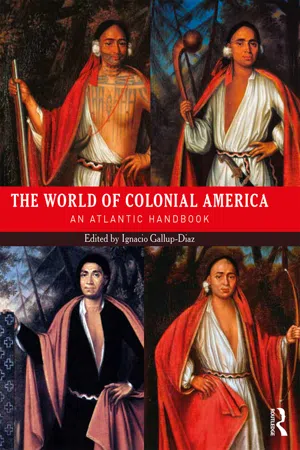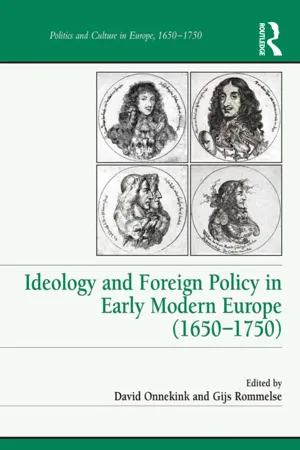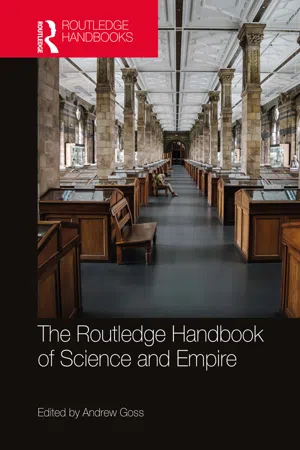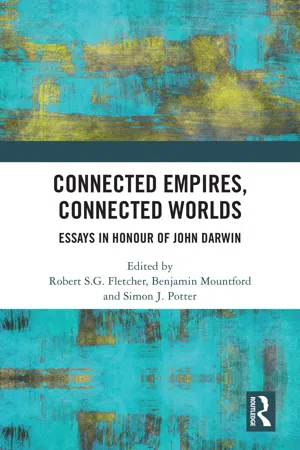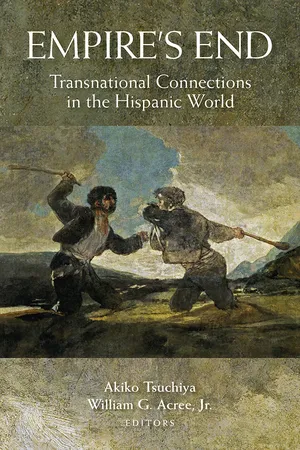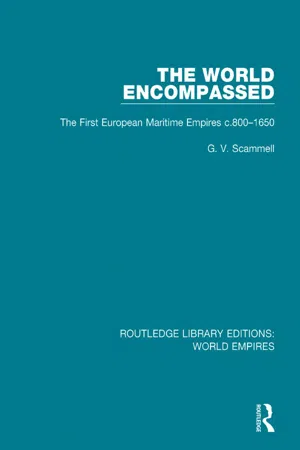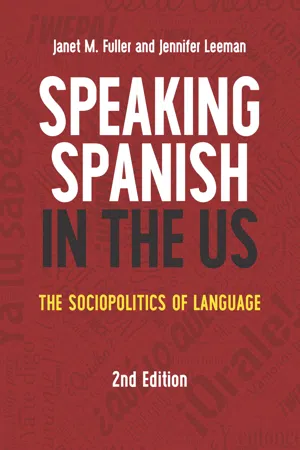History
Spanish Empire
The Spanish Empire was one of the most powerful global empires in history, spanning from the late 15th century to the early 19th century. It was characterized by extensive territorial expansion, colonization, and trade, particularly in the Americas. The empire's influence extended across Europe, Africa, Asia, and the Pacific, leaving a lasting impact on language, culture, and politics worldwide.
Written by Perlego with AI-assistance
Related key terms
9 Key excerpts on "Spanish Empire"
- eBook - ePub
The World of Colonial America
An Atlantic Handbook
- Ignacio Gallup-Diaz, Ignacio Gallup-Diaz(Authors)
- 2017(Publication Date)
- Routledge(Publisher)
1As we recognize the vast dimensions of Spain’s early modern imperium, however, it is also worth asking to what extent the crown actually exercised sovereignty over the territories and peoples it purported to rule. What are we to make of vague claims stressing the unprecedented power of the empire and its globality? Despite the formidable efforts of conquerors, missionaries, humanists, jurists, and theologians in giving physical and ideological meaning to the Spanish Empire as it expanded, the process of extending imperial rule was constantly contested. A gaping divide existed between theory and practice, between the monarchs’ capacious claims and their ability to impose effective sovereignty over those claims. Distinct from the traditional portrayal of the empire as a domineering, centralized political unit exercising supreme control over vast swathes of uninterrupted territory and millions of colonial subjects, Spanish imperial rule was, in reality, highly fragmented and often indirect, especially beyond fortified enclaves.In this chapter I examine the discourse developed to glorify and legitimize Spanish expansion, and the debates that expansion provoked. Exploring tensions between political theory, legal frameworks, and the practice of government, I analyze how large parts of the “New World” were integrated within Spain’s composite monarchy, and the enormous institutional and intellectual challenges this process presented. Finally, I assess how the monarchy attempted to rule the vast and varied territories over which it laid claim, the perisistence of indigenous forms of social, cultural, and political organization, and the generally diffuse nature of imperial power, including at the apex of Spain’s global hegemony in the sixteenth and early seventeenth centuries. - Gijs Rommelse, David Onnekink(Authors)
- 2016(Publication Date)
- Routledge(Publisher)
From the fifteenth century onwards this imperialism was aimed at achieving an imperial Spain shaped as a nation in the applied ethnic sense, with a more geographical than political meaning in the eyes of Europe. John Elliott believed that the imperial phase of Spain was circumscribed to the period beginning in 1469, with the marriage between Ferdinand of Aragon and Isabella of Castile, and ending in 1716 with the enactment of the Decree of Nueva Planta, and the start of the absolutist centralism implanted by the House of Bourbon, which also brought the end of regional political powers. 5 Henry Kamen extended this second phase to the nineteenth century, and considers the Spanish effort as the first modern globalization; in spite of the fact that the empire was not directed by anyone, surprisingly, it performed very well. A similar interpretation was offered by Anthony Pagden when he analysed the source of the ideology of the Spanish Empire within the general context of the evolution of other European empires and defined a chronology which extends from the first of Columbus’s voyages to the final defeat of the Carlist armies in South America in 1830. This was not an empire from the politico-administrative viewpoint; it was more a kind of somewhat special ‘confederate empire’, although it was not the first of this type, since similar conglomerates had existed in antiquity. 6 With regards to its political constitution, the Hispanic Monarchy opted for the court as a means of connection, given the increase in the number of kingdoms due to inheritance and dynastic privileges, annexation or conquest. Such a political configuration encouraged a number of characteristics different from those traditionally explained by historians, which were based on structures and on a progressive and rational evolution towards the formation of the state- eBook - ePub
- Andrew Goss, Andrew Goss(Authors)
- 2021(Publication Date)
- Routledge(Publisher)
18 By the early 1500s, both the Castilian crown and its composite empire were emerging projects of colonisation. As an emerging empire, Castile reorganised peoples, practices, sites, and ideas in new socio-political configurations and ways of knowing.This empire was organised around several interconnected centres—different ones at different moments throughout the years. For instance, in the first half of the sixteenth century, some of these centres were Seville, Barcelona, Santo Domingo, and Brussels; in the late sixteenth century, some of them were Mexico City, Madrid, Seville, and Lisbon. The sixteenth- and seventeenth-century Castilian empire was a long-distance empire structured around a web of geographically, politically, and legally connected sites, each with its decision-making processes, authorities, histories, and commercial and communication infrastructures (in all cases, these structures predated the presence of the Spaniards). Local authorities exercised imperial power in their areas of jurisdiction and authorities, merchants, farmers, and artisans produced local knowledge about people and things.19Christianity, Castilian, and a standard legal system brought them together into a single political unity: the Iberian Empire. However, neither Catholicism nor Castilian was the only religion or language in the empire. Muslims, Guanches, Tainos, Mayas, Mexica, Inkas, Muiscas, Mapuches negotiated, in a process of transculturation, their practices and languages as they became subjects of the empire.20They also had and produced knowledge, of course, about themselves and the land, about the animals, plants, insects, minerals, stars, gods, and spirits that lived with and around them. Like their territories and labour, this local knowledge was integrated into the empire—with different levels of success. The history of empires as a political structure that seeks to control territories, resources, and peoples is also a history about the control of local knowledge.21 This history of the empire to control local knowledge is part of the history of modern science and colonialism.22 - eBook - ePub
Connected Empires, Connected Worlds
Essays in Honour of John Darwin
- Robert S.G. Fletcher, Benjamin Mountford, Simon J. Potter, Robert S.G. Fletcher, Benjamin Mountford, Simon J. Potter(Authors)
- 2022(Publication Date)
- Routledge(Publisher)
7Moving beyond the bread and butter of colonial comparisons (namely Franco-British dynamics),8 it considers how a third party enjoying a diminished level of military prestige and political clout in the twentieth century, but with feelings of nostalgic superiority resulting from its experience dating back to the early modern period, namely Spain, engaged with the two most important empires of the era of ‘New Imperialism’. Through this triangular relationship involving Spain as the observer and the British and French empires as the observed, it seeks to illuminate hitherto neglected aspects of trans-imperial connections and mutual influences, in terms of practice, theory, and understanding, between major colonial powers.Once the leader of the Latin world, in possession of a vast array of overseas territories on which the sun never set, Spain gradually lost power to its rivals, especially France and Britain, over several centuries. Regardless of whether the Spanish assembled what amounted formally to an empire, or not, their monarchy felt sharply the loss of its worldwide clout in the wake of the Napoleonic wars, throughout the entire nineteenth century.9 It reached what has been seen in the Spanish-speaking historiography as the climax of decadence and disgrace in 1898, when it was flatly defeated by the United States (then a secondary power) which dispossessed it from its last remaining colonies as a result. The trauma caused by the defeat of 1898, and Spain’s inability to secure a large empire at a time when the race for a ‘place in the sun’ was in full swing among European powers, gave rise to sustained internal debates about the country’s future, its imperial destiny and the way in which it could break the dynamics of decline both in the metropole and overseas. These debates unfolded of course at a time when the consequences of overseas expansion, past and present, could still be felt sharply in Iberian culture.10 - eBook - ePub
Empire's End
Transnational Connections in the Hispanic World
- Akiko Tsuchiya, William G Acree, Akiko Tsuchiya, William G Acree(Authors)
- 2016(Publication Date)
- Vanderbilt University Press(Publisher)
indiano arc, as a narrative, is rewritten in literature, popular culture, and the architectural legacy of indiano houses.From the beginning of the colonization of the Americas, the Spanish monarchy carefully monitored emigration. Carlos Martínez Shaw describes its regulations: “It hardly forced anyone to move to the new lands; however, it did not permit free access to a continent that it considered its exclusive patrimony existing for the benefit of its subjects” (27). The exact nature of emigration policies varied considerably over the first three hundred years of Spanish colonialism in its American territories, but the Spanish monarchy always attempted to control the movement of persons and goods across the Atlantic. After 1824, the Spanish government lightened restrictions on emigration to the Antilles in order to facilitate the influx of Spaniards from the Iberian Peninsula; the policy reflected Spain’s concerns about maintaining the loyalty of Puerto Rico and Cuba after the wars of independence in Central and South America. However, as Birgit Sonesson has discussed, the government also attempted to keep these emigrants in Spanish territories and to prevent them from departing the islands for Venezuela. In 1848, the Spanish government outlawed emigration to South America outright, but lifted the ban in 1853 (15). The military and demographic impact of emigration was too high for Spain to allow population and economic growth in lands now out of its sphere of influence. Spaniards aspiring to escape a stifling economic situation—or, sometimes, military service—maintained a vision of the Americas as a land of economic opportunity. Such a belief was both a literary hyperbole, of which Galician peasant Ildara’s fantasy of stooping to collect gold coins rolling down the street in Emilia Pardo Bazán’s short story “Las medias rojas” is characteristic, and an incentive for emigration. The American dream survived the political upheavals of political independence during both the first third and final years of the nineteenth century. Official emigration policies continued to evolve, but even after 1898, the official end of the empire in the Americas, the former colonies continued to serve as a place for emigrants to enrich themselves. Moreover, during and after the political empire, emigration perpetuated an imperialist discourse that supposed the right of Spaniards to hacer las Américas - A.E.J. Morris(Author)
- 2013(Publication Date)
- Routledge(Publisher)
9 –Spain and her Empire DOI: 10.4324/9781315841199-9The chapter is in four parts: first, a summary of political, social and economic changes in Spain from the commencement of the reconquista (as introduced in Chapter 4 ) to the end of the eighteenth century; second, a general account of urbanism in Spain of the period, with illustrated descriptions of major cities; third, the Spanish Latin American empire, introduced separately (pages 302–4); and fourth, a summary of settlement in the Spanish Philippines, and the Portuguese colonization of Brazil.1 The settlement of those originally Spanish parts of the USA is described in Chapter 10 . Special acknowledgement is made to J H Parry’s The Spanish Seaborne Empire as a main reference source for this chapter.2_______________1 See C R Boxer, The Portuguese Seaborne Empire, 1969/1977. See also C Gibson, Spain in America, 1966: ‘the Portuguese marine attack of 1415 upon the fortified Moslem city of Cueta was … the first act of state-directed imperialism of modern European history’.2 The main general chapter reference is J H Parry, The Spanish Seaborne Empire, 1977 , a volume in the History of Human Society series; the other most useful historical background references are J H Elliott, Imperial Spain 1469–1716, 1963/1983; G Pendle, A History of Latin America, 1976/1990; J B Lockhart and S B Schwartz, Early Latin America: A History of Colonial Spanish America and Brazil, 1983/1989. The general urban histories which have been found most useful are J E Hardoy, ‘Two Thousand Years of Latin American Urbanisation’, in J E Hardoy and C Tobar (eds) Urbanisation in Latin America, trans. F M Trueblood, 1975 (as an updated and expanded version of the article of the same name in La Urbanizacion en America Latina, 1969 ); various of the chapters, as individually referenced, included in R P Schaedel, J E Hardoy and N S Kinzer (eds) Urbanisation in the Americas from its Beginnings to the Present, 1978; and also chapters in G H Beyer (ed.) The Urban Explosion in Latin America- eBook - ePub
The World Encompassed
The First European Maritime Empires c.800-1650
- G. V. Scammell(Author)
- 2018(Publication Date)
- Routledge(Publisher)
And such was the true impact of Spain. A white society was established in the Americas. Some primitive peoples were wiped out, the native populations almost everywhere drastically reduced. But in many parts of the continent Spanish influence was modest or negligible. In the heartlands of the empire indigenous states were overthrown, the ruling classes and the most notable expressions of native culture eradicated. But for the survivors life though modified by Spanish custom and belief, and lived in societies more fragmented, remained essentially Indian.VII From Cortés to Quixote
Conquests of a scale unknown since Antiquity produced in Spain all the usual features of imperial success. Castilian pride became Castilian arrogance. By and large – though there were some views and deeds to the contrary – Africans were assumed to be predestined slaves, and the defeated and passive Amerindians, the least Spanish of any people, dismissed as ‘weak and imbecile’. The redoubtable Japanese indeed elicited respect, and from the intermarriage of Spanish men with Chinese women there would spring, thought a learned Jesuit in the late sixteenth century, a race of superior mortals. Even so, some of Philip II’s soldiers and clergy in Manila regarded the conquest of China as no great matter for Spanish arms. Like the Portuguese the Spaniards came to believe themselves God’s chosen instrument to subjugate and convert the world. Conflict with the pagans, infidels and heretics who everywhere threatened Spanish safety or obstructed Spanish ambitions bred that bigotry and intolerance which characterized Iberia from the mid-1500s, and intensified the xenophobia produced by the survival in the peninsula of a large and unassimilated Moorish minority.Spain was not lifted, like Portugal, from obscurity and insignificance by empire. Already before the triumphs of the conquistadores - eBook - ePub
- Pablo Escalante Gonzalbo, Bernardo García Martínez, Luis Jáuregui, Josefina Zoraida Vázquez(Authors)
- 2013(Publication Date)
- El Colegio de México(Publisher)
[1] This potential was realized with the conquest of Mexico and the subsequent conquest of Peru, which resulted from the Spanish advancing beyond the islands and onto the continent itself.At the same time, the American continent, which did not yet have that name but was defined as the New World, began to play a role in the circuit of exchanges that was gradually beginning to encompass the globe. Such exchanges involved people, animals, plants, metals, manufactured goods, and everything associated with them, from diseases to culture. Naturally, exchange activities were managed first and foremost with a view to serving European interests, and Spanish interests in particular. That explains the evolution of colonial dependence which would characterize the Americas in the centuries to come.In general terms, that was the context in which the events associated with the beginning of the colonial era in Mexico took place. Specifically, those events originated in Cuba, where the Spaniards had already been established for almost 20 years. Wanting to expand, they organized several expeditions. In 1517, a voyage led by Francisco Hernández de Córdoba brought them to the coast of Yucatán. This trip, which was more of an exploratory journey, produced the first contact between the European and Mesoamerican worlds.The first expedition was followed by another, and a third, by then with the goal of conquest clearly in mind. This implied that the Spaniards had to resolve a variety of legal issues among themselves in order to define and regulate the privileges or rights to which the conquistadors aspired. The third expedition, organized by Hernando Cortés (also known as Hernán Cortés), left Cuba in 1519, cut off its ties there, and ended up founding a town—Veracruz—and setting up a cabildo - eBook - ePub
Speaking Spanish in the US
The Sociopolitics of Language
- Janet M. Fuller, Jennifer Leeman(Authors)
- 2020(Publication Date)
- Multilingual Matters(Publisher)
In the 16th century, Spanish arrived in what is now the US as a language of colonizers, but over the course of the 19th century it increasingly became a colonized language. As such, Spanish became subordinated to English in language ideologies (discussed in the next chapter) as well as language policies (discussed in Chapter 8). Of course, these ideologies and policies were not just about language per se; rather, they were part of a broader subordination of Spanish-speakers in which language was a tool for the exercise of power. Just as the racialization of African and Native peoples can be traced to colonial encounters and the slave trade, the Othering of Spanish-speakers and Latinxs is rooted in the period leading up to and following US territorial expansion (Vélez-Ibáñez, 2017). Black and White Legends, Hispanophilia and Oñate’s Foot At the outset of this chapter we noted that the historical presence of Spanish in the US is often overlooked. But while the periods of Spanish and Mexican rule are often omitted or downplayed in traditional accounts of US history, this does not mean that they are universally ignored. In this section we discuss the portrayal of the Spanish history of the Southwest, and of New Mexico in particular. History is never just a neutral description of the past, and historical accounts of the US’ Spanish colonial past are no exception. As we’ll show, these accounts are tied up with various political, economic and social interests, as well as with debates over the construction and representation of ethnoracial and national identities. The 16th and 17th centuries were a period of intense competition among European imperial powers and religious institutions for dominion in the Americas and around the globe. In addition to military force, imperial rivals also used political and religious propaganda to convince their subjects of the righteousness of their efforts
Index pages curate the most relevant extracts from our library of academic textbooks. They’ve been created using an in-house natural language model (NLM), each adding context and meaning to key research topics.
